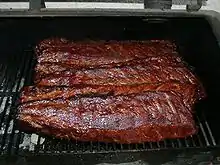Yakiniku
Yakiniku (焼き肉 or 焼肉), meaning "grilled meat", is a Japanese term that, in its broadest sense, refers to grilled meat cuisine. "Yakiniku" originally referred to western "barbecue" food, the term being popularized by Japanese writer Kanagaki Robun (仮名垣魯文) in his Seiyo Ryoritsu (i.e. "western food handbook") in 1872 (Meiji period).[1] The term later became associated with Korean-derived cuisine during the early Shōwa period.[2][3][4][5][6][7] Due to the Korean War, the terms associated with Korea in Japan were divided into North Korea (Kita Chōsen) and South Korea (Kankoku); the reference to a "yakiniku restaurant" arose as a politically correct term for restaurants of either origin.[8]
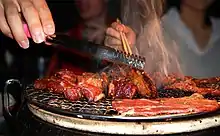 Yakiniku | |
Today, "yakiniku" commonly refers to a style of cooking bite-size meat (usually beef and offal) and vegetables on gridirons or griddles over a flame of wood charcoals carbonized by dry distillation (sumibi, 炭火) or a gas/electric grill, making it one of the most popular national dishes of Japan. In many parts of the world, yakiniku is also commonly referred to as "Japanese barbecue".[9] The origin of contemporary yakiniku has become a subject of debate, though it is conventionally considered to have been inspired by similar Korean cuisine. In 2002, the NHK program NHK Ningen Kōza (NHK人間講座, NHK Humanity Lecture) stated that: "While some tend to think that yakiniku came from Korea, it was born in post war Japan."[10] Nonetheless, it remains categorically associated with similar Korean cuisine, with various dishes, such as bulgogi, being modified to better appeal to Japanese tastes.[11]
The present style of yakiniku restaurants are derived from Korean restaurants in Osaka and Tokyo, which opened around 1945.[12] In a yakiniku restaurant, diners order prepared raw ingredients (individually or as a set) which are brought to the table. The ingredients are cooked by the diners on a grill built into the table, several pieces at a time. The ingredients are then dipped in sauces known as tare before being eaten. The most common sauce is made of soy sauce mixed with sake, mirin, sugar, garlic, fruit juice and sesame.[13][14] Garlic-and-shallot or miso-based dips are sometimes used. Korean side dishes like kimchi, nameul, bibimbap are served alongside.[15][16]
History
Etymology
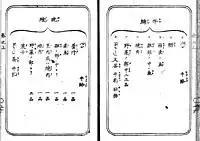
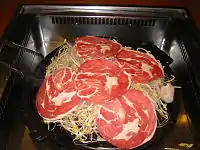
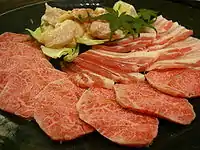
After officially being prohibited for many years, eating beef was legalised in 1871 following the Meiji Restoration[17] as part of an effort to introduce western culture to the country.[18] The Emperor Meiji became part of a campaign to promote beef consumption, publicly eating beef on January 24, 1873.[19][20] Steak and roasted meat were translated as yakiniku (焼肉) and iriniku (焙肉), respectively, as proposed western-style menus in Seiyō Ryōri Shinan[21] although this usage of the former word was eventually replaced by the loanword sutēki.
Jingisukan, the Japanese transliteration of Genghis Khan, is a style of grilling mutton, which is also referred to as a type of yakiniku. The dish was conceived in Hokkaidō, where it has been a popular blue-collar dish that has only recently gained nationwide popularity. The name Jingisukan is thought to have been invented by Sapporo-born Tokuzo Komai, who was inspired by the grilled mutton dishes of Northeastern Chinese cuisine. The first written mention of the dish under this name was in 1931.[22][23]
Origin
Common Japanese style of yakiniku, drawing heavy influences from Korean dishes such as bulgogi and galbi, became widespread in Japan during the 20th century, most notably after the Second World War. Restaurants serving this dish either advertised themselves as horumonyaki (ホルモン焼き, offal-grill) or simply Joseon (Korean) cuisine (朝鮮料理, Chōsen ryōri).[24] The division of the Korean peninsula led to disagreements in the mid-1960s in the naming of "Korean food", with pro-South businesses changing their signs to "Kankoku ryōri (韓国料理)" (named after Republic of Korea) rather than retaining the term Chōsen (Joseon), the name of the old, undivided Korea which by then had been appropriated by the North.[12]
Ventilated barbecue systems, introduced by Shinpo Co., Ltd. in March 1980,[25] quickly spread throughout Japan as it enabled diners to eat yakiniku in a smoke-free environment and greatly extended the clientele.
The popularity of yakiniku was given a further boost in 1991 when the easing of beef import restrictions led to a drop in the price of beef.[26] However, the industry was dealt an unprecedented blow in 2001 with the occurrence of BSE (mad cow disease) in Japan.
Typical ingredients
.jpg.webp)
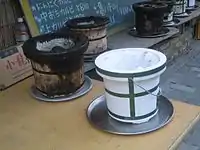
Typical ingredients include:
- Beef
- Rōsu — loin and chuck slices
- Karubi or baraniku — short ribs. From the Korean word "galbi". In Japan it is usually served without the bones, unless it is specified as hone-tsuki-karubi.
- Harami — tender meat around the diaphragm.
- Tan — beef tongue. From the English word "tongue". Often served with crushed Welsh onion (Allium fistulosum), salt and lemon juice.
- Misuji — tender meat around the shoulder.
- Pork
- Butabara — pork belly.
- P-toro / Tontoro — fatty meat around the cheek and the neck. From the word "Pork toro".
- Horumon or motsu — offal. Horumon means "discarded items" and comes from the Kansai dialect.
- Rebā — beef liver. From the German word "Leber".
- Tetchan — intestine. From the Korean word "Dae-chang(대창, 大腸)". May simply be referred to as horumon.
- Hatsu — heart. From the English word "heart".
- Kobukuro — Pork uterus. Enjoyed for its gristly texture.
- Tēru — From the English word "tail". Slices of beef tail cut crosswise, bone attached.
- Mino / Hachinosu — beef tripe
- Gatsu — Pork stomach. From the English word "gut".
- Chicken
- Seafood — squid, shellfish, shrimp.
- Vegetables — bell pepper, carrots, shiitake and other mushrooms, onions, cabbage, eggplant, bean sprout (moyashi), garlic and kabocha squash are common.
Yakiniku Day
In 1993, the All Japan Yakiniku Association proclaimed 29 August as official "Yakiniku Day" (yakiniku no hi), a form of goroawase (numerical wordplay), as the date 8月29 can be (roughly) read as ya-(tsu)ki-ni-ku (8 = ya, 2 = ni, 9 = ku).
Examples from popular culture
- In the Japanese Version of Tomodachi Life, the food was featured and briefly shown in the Nintendo Direct April 3 trailer for Tomodachi Life.
See also
- Asado
- Yakitori
- Teriyaki
- Teppanyaki
- Shichirin
- Yakisoba
- Galbi
- Bulgogi
- Gyu-Kaku, a chain of yakiniku restaurants
- Cuisine of Japan
- Barbecue
- Korean barbecue
 Food portal
Food portal
References
- "西洋料理通. 巻上,附録 / 仮名垣魯文 編; 暁斎 画".
- Modern Japanese cuisine: food, power and national identity, Katarzyna Joanna Cwiertka
- Lie, John (2001). Multiethnic Japan. Harvard University Press, 77 ISBN 0-674-01358-1
- japan-guide.com "Yakiniku-ya specialize in Korean style barbecue, where small pieces of meat are cooked on a grill at the table. Other popular Korean dishes such as bibimba are also usually available at a yakiniku-ya."
- Chantal Garcia Japanese BBQ a best kept L.A. secret, Daily Trojan, 11/10/04
- Noelle Chun Yakiniku lets you cook and choose, The Honolulu Advertiser, August 20, 2004
- Yakiniku and Bulgogi: Japanese, Korean, and Global Foodways 中國飲食文化 Vol.6 No.2 (2010/07)
- Lie, John (2008). Zainichi (Koreans in Japan): Diasporic Nationalism and Postcolonial Identity. University of California Press. p. 73. ISBN 978-0-520-25820-4.
- Lie, John (2001). Multiethnic Japan. Harvard University Press. p. 77. ISBN 0-674-01358-1.
- 2002年6月~7月期(月曜日)大好きな韓国 四方田犬彦 第五回「食事に見る世界観
- Race, Ethnicity and Migration in Modern Japan: Indigenous and colonial others, Michael Weiner (P236) "Yakiniku is a Japanese word simply meaning "cooked meat" and used to denote a grilled meat cuisine found in Korean restaurants in Japan. The mainland Korean equivalent is Bulgogi but the two cuisines are not entirely the same Yakuniku is a variant of cooked meat that has been modified by Zainichi Koreans to appeal to Japanese tastes."
- pulgogi.net "History of Yakiniku" "昭和20年頃、焼肉屋のルーツといわれる東京の「明月館」、大阪千日前の「食道園」が開店しました。" ・ "昭和40年代 朝鮮半島問題がきっかけとなって、韓国を支持する派閥が自らの店を「韓国料理屋」と名乗りました。これに伴い、それまで全てが「朝鮮料理」「ホルモン屋」であったモノが、北朝鮮を支持する経営者が「焼肉店」を名乗るようになりました。これは苦肉の策で、プルゴギを日本語に直訳しました"
- "焼肉のたれ 辛口". エバラ食品. Retrieved Sep 27, 2019.
- "焼肉のたれ 醤油味". エバラ食品. Retrieved Sep 27, 2019.
- "The Chosun Ilbo (English Edition): Daily News from Korea - How Korean Cuisine Can Compete in the World". The Chosun Ilbo. February 5, 2008.
- Manhattanites Served Korean Food as Japanese, Chosun Ilbo, Feb.4,2008.
- (in Japanese) 日本における肉食の歴史, 歴史と世間のウラのウラ
- (in Japanese) 館内展示パネル-洋食 欧米食と和食の融合, Kikkoman Institute for International Food Culture
- Donald Ritche What made Japan join the fast-food nations?, The Japan Times, March 11, 2007.
- "PORTA統合のお知らせ".
- (in Japanese) 敬学堂主人 (Keigakudō shujin) 西洋料理指南 (Seiyō Ryōri Shinan), 1872, P28.
- (in Japanese) /03.html「探偵団がたどる ジンギスカン物語」調査報告その3 ルーツを探る Archived 2004-08-13 at the Wayback Machine, Hokkaido Shimbun, 2003/01/09.
- "Ghengis Khan gets hip", The Japan Times, Feb. 3, 2006.
- 戦後ホルモン焼きから誕生した焼肉 素材を生かし肉を楽しむ食べ方へ. KoreaWorldTimes (in Japanese). 2020-01-22. Retrieved 2020-09-05.
- (in Japanese) 会社概要-沿革 Archived 2008-02-13 at the Wayback Machine Shimpo Co., Ltd. "1980年3月 無煙ロースター(モスマック)の販売を開始。(introduced a smokeless roaster (Mosumakku) in March, 1980)." OGASAWARA SEIJI (小笠原静司)/SHINPO KK, ロースターの排気システム 特公昭57-052050 (EXHAUST SYSTEM OF ROASTER, JPB57075620 (1982)). YAMADA TAKESHI (山田武司)/SHINPO KK, ロースターの消煙装置 特開昭61-234822 (SMOKE DISTINCTING APPARATUS OF ROASTER, JPA61234822 (1986)).
- Kazuhiro Soga (曽我 和弘, Soga Kazuhiro), Kansai food business society, http://shokubi.hp.infoseek.co.jp/soga.htm 炭火焼きブームは何故起こったのか], "この炭火焼ブームは焼肉ブームに端を発している。規制緩和の問題により、肉が輸入自由化となり、米・豪から安い輸入肉が入るようになった。このことにより激安焼肉店が生まれてくるわけだが、店としては「肉が旨い」というフレーズを使いたい。かといってその代名詞である「和牛オンリー」とは言いづらい、そのため「旨い」という印象を与える「炭火」という言葉を使ってそのイメージアップをはかっているのである。"
External links
| Wikimedia Commons has media related to Yakiniku. |
| Wikibooks Cookbook has a recipe/module on |
- Yakiniku Web, the official site of the All Japan Yakiniku Association (in Japanese)
- 'Life picture of east Asia' 2008-2 Kanagawa University (in Japanese), p. 112
